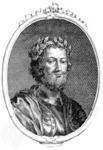Reign 971–995 Name Kenneth of Predecessor Cuilen Parents Malcolm I of Scotland | ||
 | ||
Children Malcolm II of Scotland, Boite mac Cinaeda Grandchildren Bethoc, Gruoch of Scotland, Thorfinn the Mighty Similar People Malcolm II of Scotland, Kenneth MacAlpin, Kenneth III of Scotland, Duncan I of Scotland, Constantine III of Scotland | ||
Grandparents Donald II of Scotland | ||
Cináed mac Maíl Coluim (Modern Gaelic: Coinneach mac Mhaoil Chaluim anglicised as Kenneth II, and nicknamed An Fionnghalach, "The Fratricide"; died 995) was King of Scots (Alba). The son of Malcolm I (Máel Coluim mac Domnaill), he succeeded King Cuilén (Cuilén mac Iduilb) on the latter's death at the hands of Rhydderch ap Dyfnwal in 971.
Contents
Children
Kenneth's son Malcolm II (Máel Coluim mac Cináeda) was later king of Alba. Kenneth may have had a second son, named either Dúngal or Gille Coemgáin. Sources differ as to whether Boite mac Cináeda should be counted a son of Kenneth II or of Kenneth III (Cináed mac Duib). Another son of Kenneth may have been Suibne mac Cináeda, a king of the Gall Gaidheil who died in 1034.
Interpretation
Kenneth's rival Amlaíb, King of Scotland is omitted by the Chronicle of the Kings of Alba and later Scottish king-lists. The Irish Annals of Tigernach appear to better reflect contemporary events. Amlaíb could be a direct predecessor of Kenneth who suffered damnatio memoriae, or the rival king recognized in parts of Scotland. A period of divided kingship appears likely.
Amlaíb was the heir of his brother Cuilén, who was killed in a hall-burning. He might have served as a regent north of the River Forth, during the absence of his brother. Kenneth was brother to the deceased Dub, King of Scotland and was most likely an exile. He could claim the throne due to the support of friends and maternal kin. He was likely older and more experienced than his rival king. Amlaíb is the Gaelic form of Óláfr, suggesting maternal descent from Norsemen. He could possibly claim descent from the Uí Ímair dynasty. Alex Woolf suggests he was a grandson of Amlaíb Cuarán, King of Dublin or his cousin Olaf Guthfrithson, which suggests his own group of supporters.
Death
According to John of Fordun (14th century), Kenneth II of Scotland (reigned 971-995) attempted to change the succession rules, allowing "the nearest survivor in blood to the deceased king to succeed", thus securing the throne for his own descendants. He reportedly did so to specifically exclude Constantine (III) and Kenneth (III), called Gryme in this source. The two men then jointly conspired against him, convincing Lady Finella, daughter of Cuncar, Mormaer of Angus, to kill the king. She reportedly did so to achieve personal revenge, as Kenneth II had killed her own son. Entries in the Chronicles of the Picts and Scots, collected by William Forbes Skene, provide the account of Finnela killing Kenneth II in revenge, but not her affiliation to Constantine or his cousins. These entries date to the 12th and 13th centuries. The Annals of Ulster simply record "Cinaed son of Mael Coluim [Kenneth, son of Malcolm], king of Scotland, was deceitfully killed", with no indication of who killed him.
In the account of John of Fordun, Constantine the Bald, son of King Cullen and Gryme were "plotting unceasingly the death of the king and his son". One day, Kenneth II and his companions went hunting into the woods, "at no great distance from his own abode". The hunt took him to Fettercairn, where Finella resided. She approached him to proclaim her loyalty and invited him to visit her residence, whispering into his ear that she had information about a conspiracy plot. She managed to lure him to "an out-of-the-way little cottage", where a booby trap was hidden. Inside the cottage was a statue, connected by strings to a number of crossbows. If anyone touched or moved the statue, he would trigger the crossbows and fall victim to their arrows. Kenneth II gently touched the statue and "was shot though by arrows sped from all sides, and fell without uttering another word." Finella escaped through the woods and managed to join her abettors, Constantine III and Gryme. The hunting companions soon discovered the bloody king. They were unable to locate Finella, but burned Fettercairn to the ground. Smyth dismisses the elaborate plotting and the mechanical contraption as mere fables, but accepts the basic details of the story, that the succession plans of Kenneth II caused his assassination. Alan Orr Anderson raised his own doubts concerning the story of Finella, which he considered "semi-mythical". He noted that the feminine name Finnguala or Findguala means "white shoulders", but suggested it derived from "find-ela" (white swan). The name figures in toponyms such as Finella Hill (near Fordoun) and Finella Den (near St Cyrus), while local tradition in The Mearns (Kincardineshire) has Finella walking atop the treetops from one location to the other. Anderson thus theorized that Finella could be a mythical figure, suggesting she was a local stream-goddess. A later passage of John of Fordun mentions Finele as mother of Macbeth, King of Scotland (reigned 1040–1057), but this is probably an error based on the similarity of names. Macbeth was son of Findláech of Moray, not of a woman called Finella.
